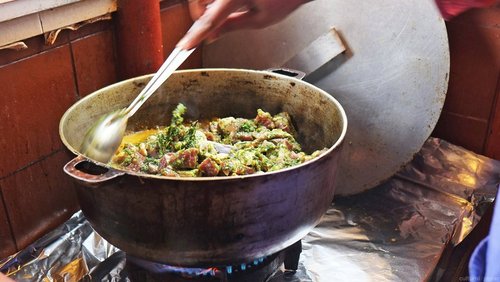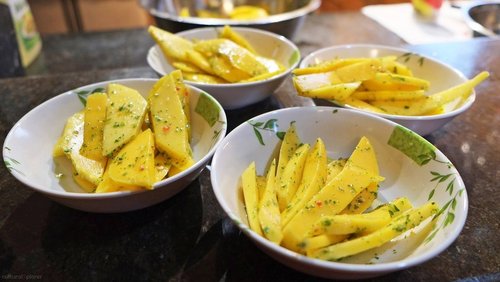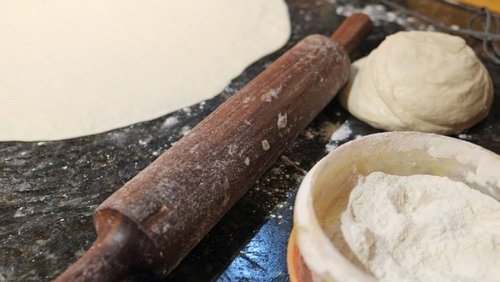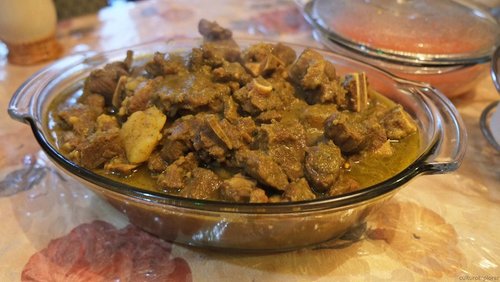Postby TriP » March 13th, 2016, 3:13 pm
People of Trinidad and Tobago ~ Dolly
Dolly League of Kitchens
Born and raised on the Caribbean island of Trinidad, Dolly has resided in numerous parts of the world including Canada, several states in the United States, and currently she resides in Queens, New York City, where she lives with her husband and four out of five of her children.
Dolly explained to us that during the cooking lesson we would be making some of Trinidad’s most common dishes: Curry Goat, Chana and Aloo, Dal, Buss-Up-Shut Roti, and Mango Chow.
She went on to tell us about the history of Trinidadian cuisine and how the unique culinary scene formed during British colonization on the island in the 1800s. During that time period, the British brought Chinese, Indian, and African people to the island to work as laborers and slaves. In addition to bringing their languages and cultures with them, the Africans, Chinese, and Indians also brought their culinary traditions with them, which blended over time and created the Trinidadian food we know today.
When we finished eating, Dolly handed us aprons and led us out to her second kitchen, an area of her house that she converted from a back porch into a kitchen area, as she does a large amount of cooking.
Dolly League of Kitchens
We started by learning how to make Curry Goat, a dish that is comprised of the shoulder of a goat that is then marinated in Trinidadian green seasoning and habanero pepper before being stewed in turmeric and curry powder until it is perfectly tender.
After getting a demo on making green seasoning by Dolly, I was placed in charge of helping to blend parsley, thyme, shado beni, cilantro, scallion, and garlic together to make the green seasoning that we would smother over top of the curry goat for it to marinate in before we cooked it.
After the goat was finished marinating, Dolly placed it in a large pot with oil, turmeric, and Trinidadian Kala Brand Madras Curry powder (which she swears by), and let it cook for two hours.
While we were waiting for the goat to cook and get tender and juicy, we continued making various dishes under the instruction and close guidance of Dolly. The next item up on the menu was Chana and Aloo, a dish comprised of dried chickpeas that had been soaked overnight, potatoes, turmeric, madras curry powder, habaneros, and shado beni.
One important thing that I learned from Dolly about Trinidadian cooking is that there are no exact measurements; we would throw in a ‘handful’ of this and a ‘dash’ of that, and somehow everything came out amazing. Another thing that Dolly taught us is that after someone has had a lot of experience cooking Trinidadian food, they will automatically know how much of certain ingredients to use; therefore, tasting does not have to be done while cooking. Unlike traditional cooking where you taste test the food you are cooking as you go along, Dolly does not do that. The only time she tastes the food is when it is finished cooking and it is ready to be consumed.
Chana and Aloo League of Kitchens
Dolly creating Chana and Aloo
Dash of Salt Trinidadian cooking
Dolly using a handful of salt when cooking; no measurement cup needed
While the Chana and Aloo were cooking on the stove, we moved on to making the next dish: Mango Chow, a dish comprised of sliced mango that is tossed with green seasoning, green habanero peppers, and salt. Mango Chow is an interesting and delicious dish that combines the sweet taste of the mango with the spiciness of hot red peppers.
After slicing the mangoes and seasoning them, we were all hungrily eyeing the dish, which Dolly told us to enjoy as a snack while we waited for the main dishes to finish cooking. After snapping a few quick photographs, we each quickly devoured the mangoes.
The final two things that we made during the cooking class were Dal, which are split yellow peas that are combined with seasonings and pureed into a thick soup, and Buss-Up-Shut Roti, which is a buttery and flaky flatbread that is torn to resemble a busted up shirt.
The Buss-Up-Shut Roti was probably one of the most enjoyable (and involving) parts of the meal to make. The process of making the roti first starts with rolling out the flour into a large circle, and then placing it on a massive griddle where you fry it with oil and then break it up with two large wooden paddles. Having a lack of upper body strength made the process a of breaking up the roti a little bit challenging but a lot of fun.
Finally after about three hours of being in the kitchen, the time came to eat. After taking some obligatory food photographs (because what is more fun than taking pictures of what you eat?), my group and I sat down to eat. As we broke bread, we talked about how fun the experience was, about Dolly’s life in Trinidad and her life in New York, and about how we were going to attempt to make these dishes at home.
One thing I always say is that food truly is a connecting force and has the power to bring people together. I learned so much from Dolly about Trinidadian food and culture and how integral food is to her life. It was truly a wonderful experience and I am looking forward to learning more about Trinidadian and West Indian foods in the future!
A huge thank you to the League of Kitchens who provided a complimentary cooking class to myself and a guest. As always, all opinions are entirely my own. If you are interested in taking one of the many class offerings by the League of Kitchens, check out their website and tell them that I sent you!
-
Attachments
-

-

-

-

-





